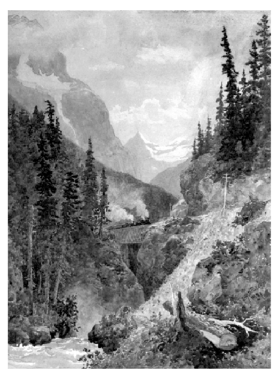Kicking Horse Pass
| Kicking Horse Pass | |
|---|---|
|
1887 painting | |
| Elevation | 1,627 m (5,338 ft) |
| Traversed by | Trans-Canada Highway & Canadian Pacific Railway |
| Location | Banff National Park, Alberta / Yoho National Park, British Columbia, Canada |
| Range | Canadian Rockies |
| Coordinates | 51°27′10″N 116°17′00″W / 51.45278°N 116.28333°WCoordinates: 51°27′10″N 116°17′00″W / 51.45278°N 116.28333°W |
| Official name | Kicking Horse Pass National Historic Site of Canada |
| Designated | 1971 |

Kicking Horse Pass (el. 1627 m, 5339 ft) is a high mountain pass across the Continental Divide of the Americas of the Canadian Rockies on the Alberta/British Columbia border, and lying within Yoho and Banff National Parks. A National Historic Site of Canada, the pass is of historical significance because the main line of the Canadian Pacific Railway (CPR) was constructed between Lake Louise, Alberta and Field, British Columbia using this route in 1880s, in preference to the originally planned route through the more northerly Yellowhead Pass.[1]
The pass was first explored by Europeans in 1858 by the Palliser Expedition led by Captain John Palliser. The pass and the adjacent Kicking Horse River were given their names after James Hector, a naturalist, geologist, and surgeon who was a member of the expedition, was kicked by his horse while exploring the region.[2]
The original route of the CPR between the summit of the pass near Wapta Lake and Field was known as "The Big Hill"; with a ruling gradient of 4.5 percent (1 in 23), it was the steepest stretch of main-line railroad in North America.
Due to frequent accidents and expensive helper engines associated with railroading in the pass, the CPR opened a pair of Spiral Tunnels in 1909 that replaced the direct route. Although these tunnels add several kilometres to the route, the ruling grade was reduced to a more manageable 2.2 percent (1 in 46).
The Trans-Canada Highway was constructed through the pass in 1962 following essentially the original CPR route. It reaches its highest point at the Kicking Horse Pass with an elevation of 1,643 metres (5,390 ft).[3]
Divide Creek, a creek that forks onto both sides of the Continental Divide, is located at Kicking Horse Pass.
Dave Broadfoot played The Honourable Member for Kicking Horse Pass in the CBC Television satirical series Royal Canadian Air Farce and in his personal standup routines.
Images
 Looking easterly at the Kicking Horse Pass from the Trans Canadian Highway
Looking easterly at the Kicking Horse Pass from the Trans Canadian Highway
See also
References
- ↑ Kicking Horse Pass. Canadian Register of Historic Places. Retrieved 22 January 2012.
- ↑ Shaughnessy Bishop-Stall, Canadian Geographic, Jan/Feb 2008, p. 24
- ↑ B.C. Trans-Canada Highway
External links
| Wikimedia Commons has media related to Kicking Horse Pass. |
- Zoomable map of Kicking Horse Pass showing railway
- Ten Mile Hill Project HD Video
- LibriVox Audiobook Recordings
